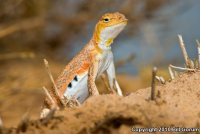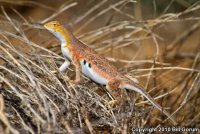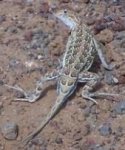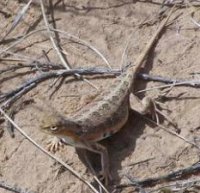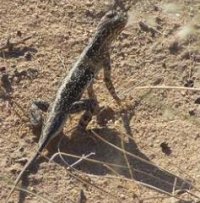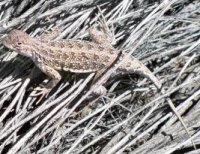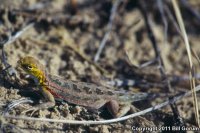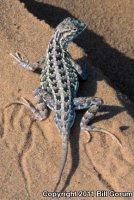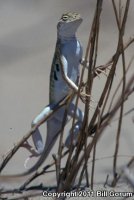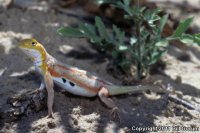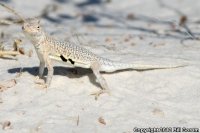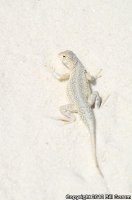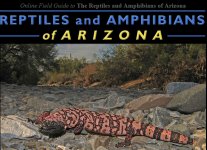| Range: |
 |
| Other Names: |
Lesser Earless Lizard |
| Subspecies: |
H. m. approximans Speckled Earless Lizards are smaller than the Great Plains Earless Lizard with less pronounced ventral lateral bars and less developed dorsal tail chevrons.
H. m. maculata Great Plains Earless Lizards are larger than the Speckled Earless Lizard with pronounced ventral lateral bars and highly developed dorsal tail chevrons.
H. m. ruthveni Bleached Earless Lizards have much lighter coloring and sometimes can be almost completely white. |
| Description: |
A small (up to 70 mm or 2.75" from snout to vent), gray, tan, or orange-brown lizard with variable markings. Coloration usually matches the soil on which the lizard lives. Body markings usually consist of four rows of brown blotches or chevrons extending from the neck to the tail and light speckles on the upper surfaces of the body and limbs. Some specimens lack markings. Two black bars mark each lower side of the body just behind the forelimb. Males often have a yellow tint on the lower sides, blue outlines around the side bars, copious light speckling, and less distinct dorsal blotches. Gravid females often have a pink or peach tint and an orange throat patch. As its common name implies, this lizard lacks external ear openings. The scales are small and granular. |
| Similar Species: |
The paired bars on the lower sides of its body and its lack of ear openings distinguish this lizard from the similar looking Eastern and Plateau Side-blotched Lizard. The underside of the tail is plain white distinguishing this lizard from the Southwestern Earless Lizard. The similar Elegant Earless Lizard has a longer tail, a row of chevron markings that extends to the tip of the tail, and grows to a larger size than the Common Lesser Earless Lizard. |
| Venom: |
none |
| Habitat: |
Found in communities ranging from Semidesert Grassland, through Interior Chaparral, and into woodlands. It is usually encountered on relatively level terrain in open, sunlit areas with sparse vegetation and sandy or gravelly soil. |
| Behavior: |
This diurnal lizard is most active mid morning and late afternoon during the hottest months of summer. It can be active throughout the daylight hours in spring and early fall. |
| Hibernation: |
It hibernates during the cold months of winter and late fall. |
| Reproduction: |
Mating takes place in spring and one or two clutches of eggs are laid in spring and summer. Clutch size ranges from 1 to 10 eggs. |
| Diet: |
The Common Lesser Earless Lizard feeds on a variety of insects including grasshoppers, beetles, bees, wasps, ants, true bugs, butterflies, and moths. It also eats a variety of spiders and small lizards. |
Adapted from account on 

